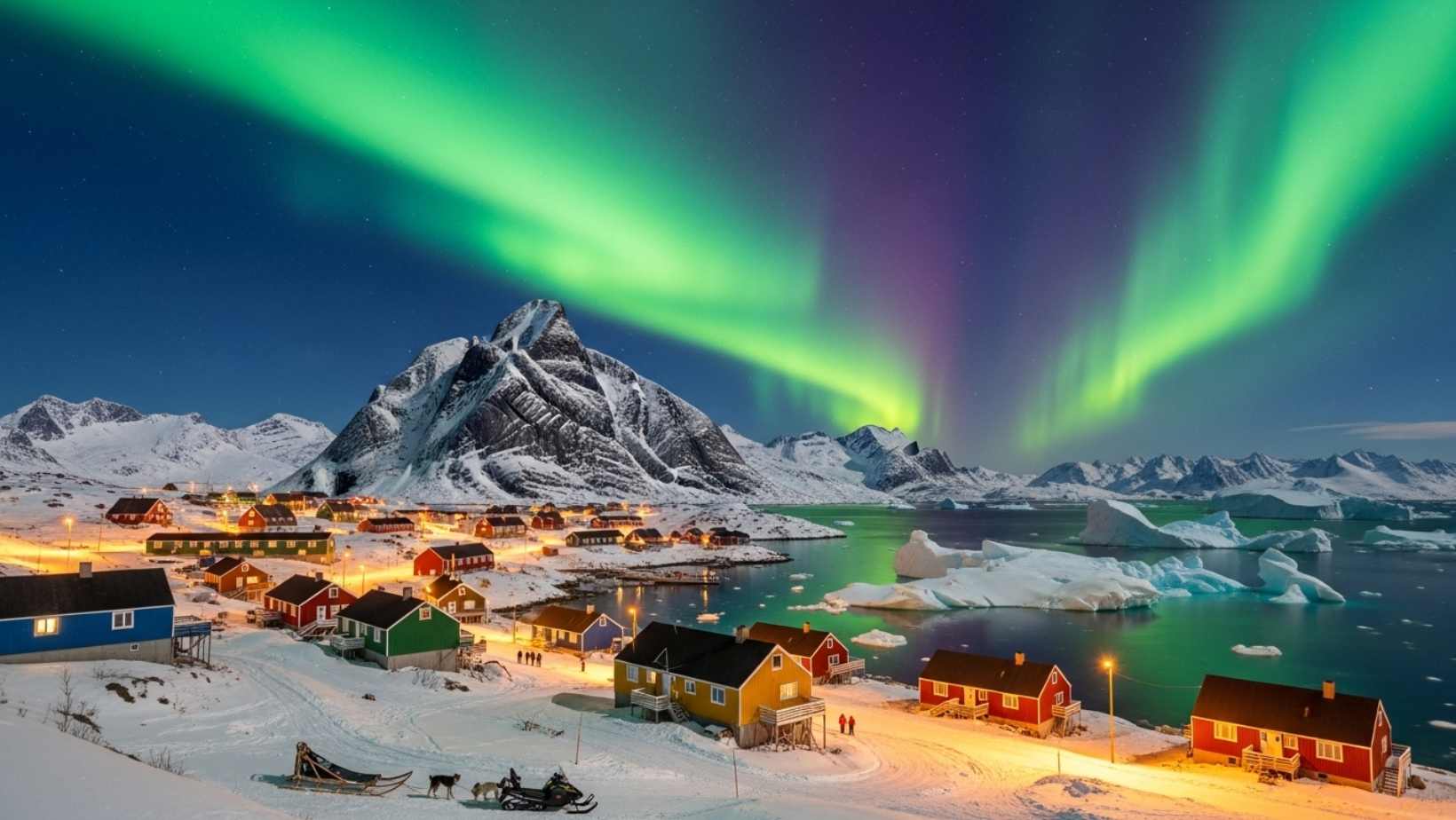Helicopter rotors slice through Arctic silence as you descend toward a cluster of colorful houses gripping East Greenland’s frozen coastline. For 243 nights each year, green ribbons of aurora borealis dance above this settlement of 89 souls. Yet search for hotels on any booking platform and you’ll find nothing. This isn’t oversight or underdevelopment – it’s a deliberate choice by one of Earth’s most isolated communities to preserve something tourism often destroys.
Ittoqqortoormiit exists where the Denmark Strait meets Scoresby Sound, the world’s largest fjord system. Summer brings three months of continuous daylight when narwhals surface between icebergs the size of apartment buildings. Winter delivers four months of polar night illuminated only by stars, moon, and those spectacular northern lights that appear with such frequency locals barely glance upward anymore.
Getting here requires either a helicopter flight from Nerlerit Inaat airport (itself reached only from Iceland) or, for the truly adventurous, a multi-day dog sled journey across sea ice that forms between February and May. The isolation isn’t accidental – it’s essential to everything this community represents.
You’ll sleep in local homes where seal hunters share stories over morning coffee
Knocking on Niels Sikkersoq’s door at minus 30 degrees Celsius, you’re welcomed into a world where hospitality predates the hotel industry by millennia. His living room walls display harpoons alongside family photos, polar bear skins cover wooden floors, and the kitchen smells of brewing coffee mixed with drying Arctic char. This is where visitors sleep – not in sterile hotel rooms but in spare bedrooms of active hunting families.
Each household maintains different arrangements. Some offer simple mattresses in heated storage rooms, others have converted entire floors into guest quarters with handmade quilts depicting local legends. Payment varies from 300 to 500 Danish kroner per night, always including breakfast of fresh bread, dried fish, and stories about yesterday’s hunt.
The morning ritual starts at 5 AM when hunters check weather conditions through frosted windows. Guests often wake to the sound of sleds being prepared, dogs barking in anticipation, rifles being cleaned. By breakfast, you’re not a tourist but a temporary member of an extended Arctic family learning which ice formations signal good seal hunting and why certain aurora patterns predict tomorrow’s weather.
You’ll understand why traditional hunting defines everything from meal times to social structure
Every aspect of Ittoqqortoormiit revolves around hunting cycles that haven’t changed since the Thule people arrived 500 years ago. Polar bear season runs September through October, seals dominate winter months, and summer brings muskoxen expeditions inland. The small community coordinates these activities through CB radios crackling in every kitchen, creating a communication network more reliable than any cellular service.
Meat distribution follows unwritten rules older than Greenland’s written history. A successful hunter feeds elders first, then families with small children, finally his own household. Nothing gets wasted – seal blubber becomes lamp oil, skins transform into clothing, bones become tools or dog food. Visitors participating in this system quickly understand it’s not poverty but profound respect for resources in an environment offering no second chances.
The community store opens three hours daily, stocked by supply ships arriving twice yearly. Fresh vegetables cost five times Copenhagen prices, making hunted meat not tradition but necessity. Yet locals serve visitors generous portions of narwhal mattak, seal soup, and reindeer stew, sharing food that represents survival itself in Earth’s most unforgiving landscape.
You’ll discover why rejecting hotels preserved what mass tourism destroys elsewhere
In 2018, international developers proposed a 50-room aurora viewing resort promising year-round employment and tourist dollars. The community meeting lasted twelve minutes before unanimous rejection. Elders remembered Ilulissat, where cruise ships disgorge thousands of passengers overwhelming a town of 4,500. They’d seen Tasiilaq transform from hunting village to Instagram backdrop.
Instead, Ittoqqortoormiit chose controlled access through home stays limiting visitors to roughly twenty at any time. This isn’t anti-tourism but sustainable cultural preservation. Guests learn proper aurora photography from teenagers who’ve watched northern lights since birth. They taste fermented walrus prepared by grandmothers maintaining recipes from before European contact.
The arrangement benefits everyone. Families earn supplementary income without abandoning hunting lifestyles. Visitors experience authentic Arctic life impossible in commercial lodges. Most importantly, children grow up seeing their culture valued, not commodified. When young Malik Rosing explains aurora legends passed through seven generations while showing guests the best viewing spots, he’s not performing for tips but sharing inheritance no hotel concierge could replicate.
This 89-person Arctic settlement proves tourism doesn’t require infrastructure destroying what travelers seek. Sometimes the most profound experiences come from sleeping where hunters dream, waking where aurora dancers perform, and understanding that certain places remain special precisely because they refuse to become destinations.
